Mastering the Circle of Fifths for Guitar Players
Today, I’m going to be talking about the Circle of Fifths, a powerful tool in the world of music. This isn’t just about recognizing notes and chords; it’s also about unlocking relationships between them. Whether you’re a budding musician or looking to refine your skills, understanding the Circle of Fifths can transform your approach to music.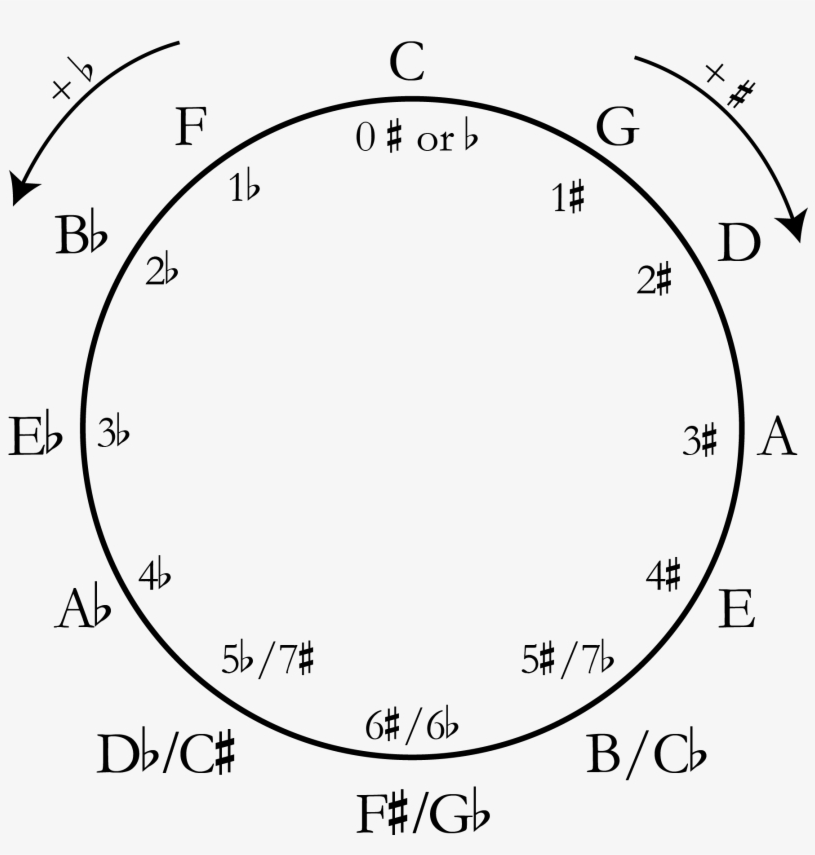
You’re going to find out about why the Circle of Fifths is a cornerstone of music theory. It’s a visual representation of how keys are related to each other, and it’s an essential guide for musicians for everything from arranging music to figuring out harmonies.
I’ll show you how it maps out the 12 tones of the chromatic scale, and how it organizes them into a logical sequence of major and minor keys. This sequence is not random; it’s rooted in acoustics and the physics of sound, and it reflects patterns that are fundamental to Western music.
You can always adjust your approach down the road, but getting a firm grasp on this concept is a game changer. It can simplify complex music theories and serve as a guidepost to navigate the vast landscape of music composition and improvisation.
Knowing the Circle of Fifths is like having a roadmap when traveling through the land of music. You won’t have to guess which key to play in next or what chords might sound good together. And the best part? It applies to any style of music, from classical to jazz to pop.

I’ll also highlight how a firm understanding of the Circle of Fifths can improve your abilities to write, understand, and perform music. This understanding lays the foundation for more advanced music theory concepts, making it easier to grow as a musician.
What is the Circle of Fifths?
The Circle of Fifths is a powerful tool for musicians, offering a comprehensive framework for understanding key signatures, chord progressions, and scale relationships. For guitar players, this circular diagram can be particularly valuable, providing a roadmap to navigate the fretboard more efficiently and creatively. This article will explore how guitarists can leverage the Circle of Fifths to enhance their musical knowledge and playing skills.
Understanding the Circle of Fifths
The Circle of Fifths is a visual representation of the 12 notes in the chromatic scale, arranged in a circle. Starting from C at the top, each note a perfect fifth apart proceeds clockwise (C, G, D, A, E, B, F#/Gb, Db, Ab, Eb, Bb, F) and counterclockwise in perfect fourths. This arrangement highlights key signatures, with sharps increasing in the clockwise direction and flats increasing counterclockwise.
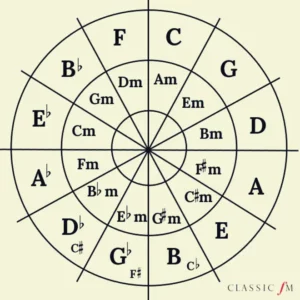
Each segment of the circle represents a key, with the major key on the outside and its relative minor on the inside. For example, C major pairs with A minor, G major with E minor, and so on. Understanding this relationship is crucial for guitar players aiming to expand their harmonic knowledge and versatility.
Practical Applications for Guitarists
1. Key Signatures and Scales
The Circle of Fifths helps guitarists quickly identify key signatures and their corresponding scales. Key of C has no sharps or flats, essentially it’s the white notes of the piano. As you progress clockwise around the Circle of Fifths, you’ll start adding sharps, or black key notes to you scales.
Every key in music is derived from a scale, which is a series of half steps and whole steps. For more information, check out this article.
Essentially, the formula for a Major Scale is W W H W W W H. Between the E and F notes and the B and C notes, there is not a black key, therefore those notes are automatically a 1/2 step interval.
As you go from C major to G major, your 1/2 step remains between B and C, but now shifts from what was E to F, and now is F# to G. This helpful to understanding what sharps or flats a key have in it.
Sharp Keys
For instance, knowing that G major has one sharp (F#), players can use this knowledge to construct the G major scale and its modes across the fretboard. Similarly, understanding the relative minor (E minor for G major) allows for smooth transitions between major and minor tonalities.

Key of D has two sharps: F# and C#.
Key of A has three: F#, C#, and G#.
Notice that as you progress around the Circle of Fifths in a clockwise direction you’re keeping the previous sharp(s) and adding a new one. At this point, you’re raising the 7th scale step 1/2 step.
Key of E has four: F#, C#, G#, and D#. The key of B has five: F#, C#, G#, D#, and A#. The next two keys F# with 6 sharps: F#, C#, G#, D#, A#, and E#, and C# with seven!!: F#, C#, G#, D#, A#, E#, and B# are the least commonly used keys.
By the way, E# is essentially the note F, and B# is really C.
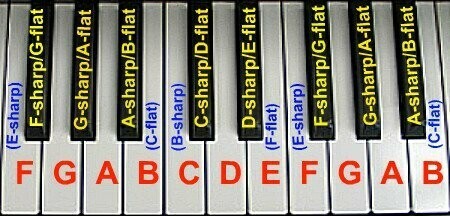
Flat Keys
Next are the flat keys. Notice that now you’re going to travel around the Circle counter-clockwise, and some call this version the Circle of Fourths, since now you are traveling through the keys using the interval of a fourth.
Key of F has one flat, Bb. If you remember the formula for the Major scale. W W H W W W H. From F to G is a whole step, as is G to A, but next you need a 1/2 step, so you then proceed to Bb. After that you have your whole step from Bb to C, likewise C to D, and D to E. Finally the last 1/2 step is from E to F.

Key of Bb has two flats: Bb and Eb. The key of Eb has three flats Bb, Eb, and Ab. Next the key of Ab has four flats: Bb, Eb, Ab, and Db. If your following the pattern, you’ll see that each time we proceed through the Circle of Fourths, we are essentially flattening the fourth scale tone.
Key of Db has 5 flats, Bb, Eb, Ab, Db, and Gb.
Key of Gb with 6 flats: Bb, Eb, Ab, Db, Gb, and Cb. Cb is essentially B. This key is rarely used. Also notice that key of Db is enharmonically the same as C#. The difference is 5 flats versus seven #’s. Likewise, you could say that key of Cb is the same as B. Again seven flats versus 5 sharps. Which one would you choose. Subsequently, key of Cb is rarely used.
Old music theory books had 15 keys, with F#/ Gb, C#/ Db and B/Cb begin the ones that became more or less obsolete
The old theory books would contain the keys of C, G, D, A, E, B, F, Bb, Eb, Ab, Db and F# plus Gb, C# and Cb. Nowadays we just count 12 keys leaving off the last three keys, Gb, C#, and Cb. Those keys aren’t used very much in today’s music, so they are pretty rare.
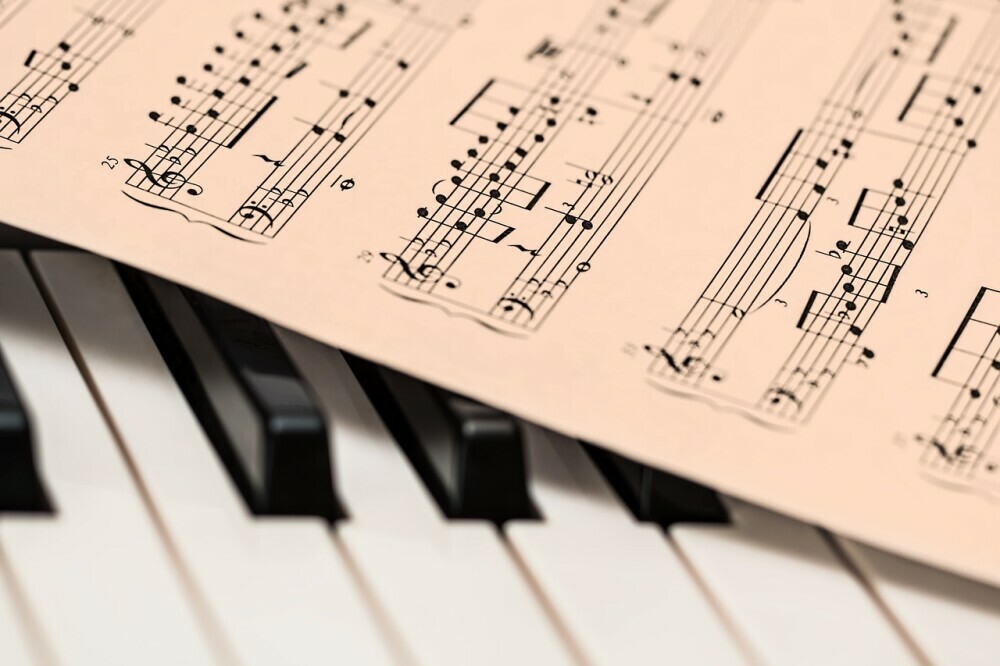
2. Chord Progressions
Chord progressions are fundamental to songwriting and improvisation. The Circle of Fifths reveals common progressions like the I-IV-V (C-F-G in C major) and ii-V-I (Dm-G7-C in C major). Guitarists can use these patterns to craft harmonious progressions and modulate between keys seamlessly.
If you start by harmonizing every note in the Major scale you get this:
CEG DFA. EGB. FAC. GBD. ACE BDF <<<< each>
I. ii iii. IV. V. vi vii. <<<< Called>
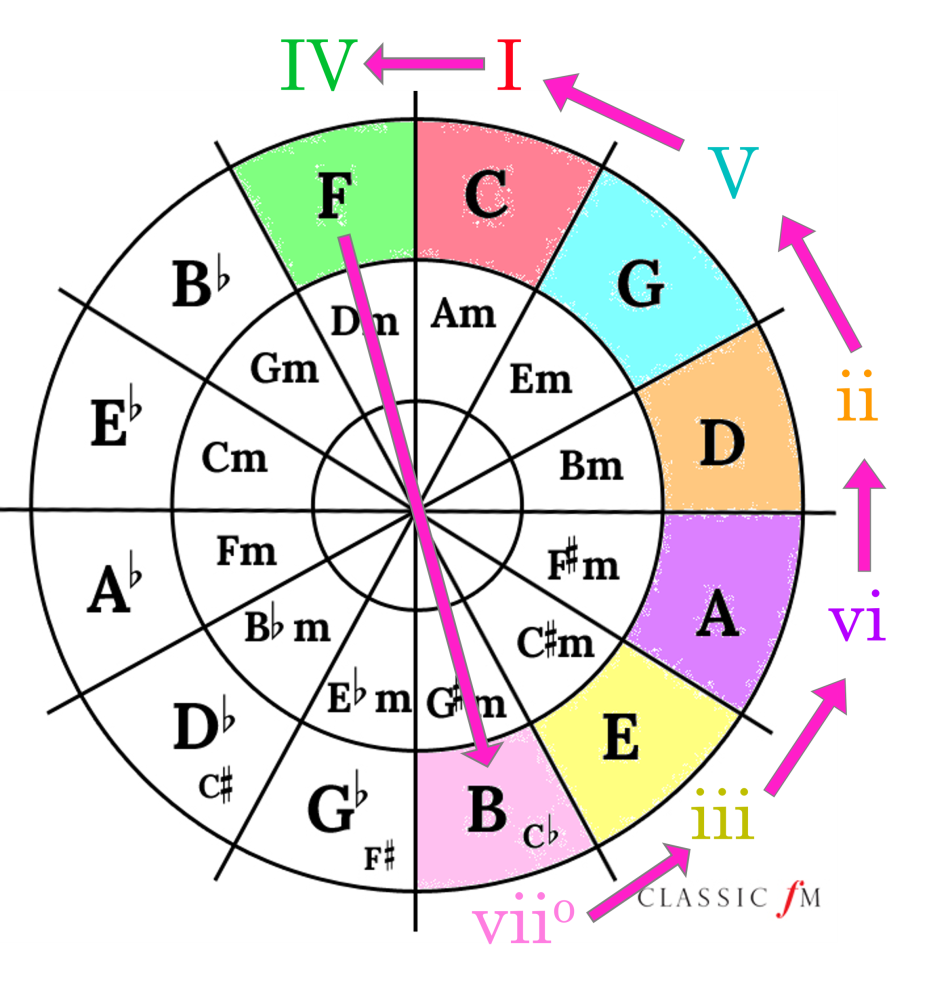 Triads are simply three note chords, and most chords we use today in Western music are based on them. More about this in another lesson later.
Triads are simply three note chords, and most chords we use today in Western music are based on them. More about this in another lesson later.
Some other common chord progressions are iii, vi, ii, V, I. In the key of C this would be Em, Am, Dm, G, C. and more advanced chord progressions such vii, iii. vi, ii, V, I. In key of C that would B dim, Em, Am, Dm, G, and C.
Most popular songs today are based on this progression: I vi IV V. In key of C this would be C, Am, F, G.
In the key of G the same chord progression (I vi IV V) would be G, Em, C, D. For the Key of D, I vi IV V would be D, Bm, G, A, etc. The amount of songs that use this chord progression is staggering.
Note: For more about seventh chords, diminished chords, and other similar jazz chords go here,
3. Transposing Songs
Transposing is the process of changing the key of a song. The Circle of Fifths makes this task straightforward. To transpose a song from C major to G major, move each chord up a fifth. For example, C major (I) becomes G major, F major (IV) becomes C major, and G major (V) becomes D major.
Understanding what we just discussed in the above examples should start to clarify this idea.
The most popular chord progression in modern music from the Blues to Rock, Pop, Funk, etc. is the I, IV, V.
Not that long ago, the 12 bar blues was based exclusively on this chord progression.
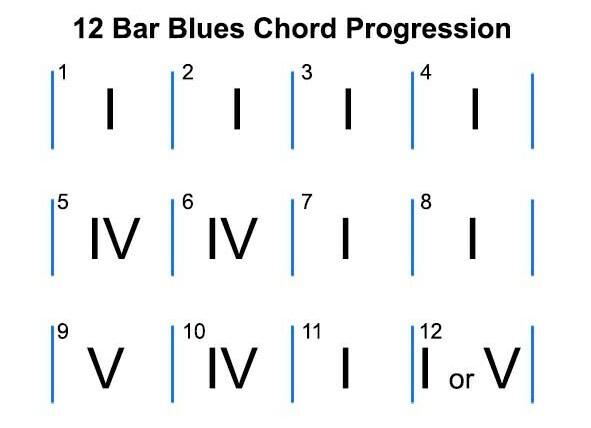
In the key of C this would look like:

4. Improvisation and Soloing
For improvisation, understanding the relationship between keys and scales is crucial. The Circle of Fifths aids in visualizing these connections. Guitarists can use it to select appropriate scales and modes for soloing over chord progressions, ensuring their improvisation remains harmonically relevant.
For example, while soloing over a 12 bar blues progression, most guitarists and other instrumentalists will typically use the Pentatonic, Blues and Mixolydian scales.
For more information on this idea. go here.
For more on the modes, go here.
5. Harmonizing Melodies
The Circle of Fifths is also useful for harmonizing melodies. By understanding the chords within a key, guitarists can create rich harmonic textures. For instance, in C major, harmonizing a melody note E could involve using C major (I), A minor (vi), or F major (IV), each offering a different color and emotional impact.
For the C chord, the C would be the third of the chord, i.e. C E G. For Am, it would be the 5th. A C E. For the F chord it would be major 7th, i.e. F A C E. That’s a very colorful melodic choice right there.
Tips for Using the Circle of Fifths
- Memorize Key Signatures: Familiarize yourself with the number of sharps or flats in each key. This knowledge will become second nature with practice. Start with the sharp keys, and then memorize the flat keys.
- Practice Chord Transitions: Use the Circle of Fifths to practice transitioning between chords in different keys. This will improve your dexterity and familiarity with the fretboard. Next practice using a variety of chord progressions such a iii, iv, ii, V.
- For this study closely related keys, for example keys of C, G, and F, or G, D, and A.
- Next practice using a variety of chord progressions such a iii, iv, ii, V, I.
- Experiment with Modulation: Try modulating between keys using the Circle of Fifths. Start with closely related keys (one step away on the circle) and gradually explore more distant relationships.
-
- For example, try going from keys such as G, B, and Eb (think Giant Steps by John Coltrane.)
- Another example would be: keys of Ab, C, Eb, G, and E (think All The Things You Are)
-
- Explore Relative Minors: Incorporate relative minors into your playing to add depth and variety to your music.
- For instance, key of C’s relative minor is Am, key of G is Em, key of D is Bm, and key of F is Dm.
Conclusion
The Circle of Fifths is an indispensable tool for guitarists, providing a structured approach to understanding music theory, key signatures, chord progressions, and more. By integrating this powerful diagram into your practice routine, you’ll gain a deeper understanding of the fretboard, enhance your improvisational skills, and become a more versatile and creative musician. Whether you’re a beginner or an advanced player, the Circle of Fifths can open new doors to musical exploration and mastery.


Great article.
I already know the circle of fifth, since I learned by heart its four component :
The list of Major scales in increasing order of sharps at the key
The list of Major scales in increasing order of sharps at the key
The list of # (the order in which they appear on a partition)
The list of b (the order in which they appear on a partition)
in my music theory course, I was just asked to learn them by heart.
I did, without asking, and it just made everything so much easier afterwards…
In French, where notes have other names than letters it might be easier, because it becomes a list of syllables. (ex : sol ré la mi si fa# do#, so it is just a sound to remember)
You say somewhere : each note a perfect fifth apart proceeds clockwise…
I would have said : each note a perfect fifth or fourth depending on if you see it clockwise, or counterclockwise, / with next note higher or lower.
Well you asked for a comment, so this was it 😉
I should have said :
The list of Major scales in increasing order of # at the key
The list of Major scales in increasing order of b at the key (error corrected here)
The list of # (the order in which they appear on a partition)
The list of b (the order in which they appear on a partition)
I have been playing the guitar since the age of 12 years old, but I must admit visiting your website I have learned some new things about playing the guitar.
The circle of fifths is new to me despite I have been playing the guitar for years, I am happy that I have found your website to learn even more about playing the guitar.
Wow, I must admit visiting your website has been an educational experience for me. I am going to save your website on my favorites for easy access to visit your website often.
Thank you for a great day
Jeff
Awesome Jeff! Thank you brother… I pray that I can continually update it so that it provides value to you! Thanks again!